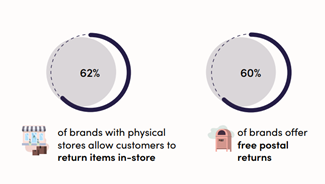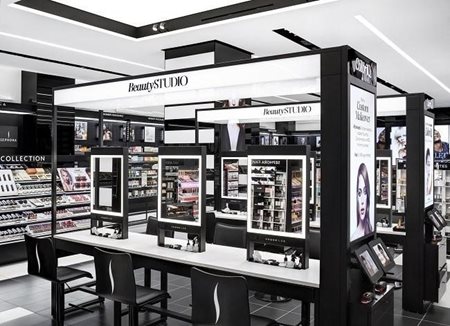The All-Encompassing Opportunity of Omnichannel
One common adage of business is that the customer is king.  Well, that ‘king’ now embraces shopping online; expertly navigating several apps to hunt for the lowest prices, and expecting free shipping, same-day delivery, and returns. Retail and business owners have their work cut out for them in trying to keep up with today’s consumers. The concept of omnichannel was born out of a need to meet the ever-increasing demands of customers while offering the most seamless experience possible.
Well, that ‘king’ now embraces shopping online; expertly navigating several apps to hunt for the lowest prices, and expecting free shipping, same-day delivery, and returns. Retail and business owners have their work cut out for them in trying to keep up with today’s consumers. The concept of omnichannel was born out of a need to meet the ever-increasing demands of customers while offering the most seamless experience possible.
As with nearly everything in our modern world, the internet has revolutionized shopping. Consumers now have access to almost anything that can be dreamt of — anytime, anywhere. With an effortless click of a button, buyers can obtain what they need or want, delivered to their door, without ever stepping foot into a store. And yet, despite the convenience of having apps and browser extensions that can apply discount codes to carts, drones that can deliver orders in mere hours, and countless virtual applications and online reviews, people still like to shop in stores.
Regardless of forecasts and predictions, retail is not dead. The business of retail and commerce is simply changing, and perceptive brands have understood that the customer is at the heart of the transformation. Brands like Sephora, Nike, Ikea, and Disney have recognized that the way to succeed in today’s commerce climate is to adapt and adopt an omnichannel approach.
A step-up from the already dated multi-channel approach, omnichannel aims to fuse and blend all communication channels to create a seamless experience for the consumer. Where in the past, businesses have spent time, money, and energy focusing on creating responsive websites, social media strategies, and mobile marketing, omnichannel will serve to bring all of these elements together and have them work in unison.
The “State of Omnichannel 2019” report, by Veeqo, analyzed over 63 popular fast-fashion brands ranging from household names like H&M and Forever21, to NastyGal and Fashion Nova. The report identifies five ‘elements’ that play a crucial role in the omnichannel strategy:
- Unity between online and physical
- Multi-device shopping
- Delivery
- Returns
- Customer support
I found the report managed to touch on some vital points and was loaded with fascinating data. It also made me wonder how omnichannel fares in other markets? What can we learn from this report and the findings that translate to other industries? Let’s explore.
Online Store versus Physical Store
Are brick and mortar stores obsolete? The debate rages on.
It turns out that 37% of brands do business exclusively online, while 62% of brands do both online and physical stores. While many would believe that retail is moving towards online, the findings in the Veeqo report suggest that might not be the case. Not in the fashion
 Source: Veeqo
Source: Veeqo
sector, anyway. Their results show that up to 82% of shoppers do like to use their mobile devices to research purchases, but most of those transactions — 73%, according to Veeqo — happen in physical stores. This is primarily due to discerning consumers feeling that it’s essential to touch and try on the items in the store.
It is important to acknowledge that these findings showcase numbers in a specific sector, which is why omnichannel strategies need to be customized to the industry, client segments, and locations, among other parameters. Everyone is well aware of the impact that the likes of Netflix and Spotify have had on video rental and music stores.
Different generations have different shopping habits. More than half of Gen Xers and Millennials prefer shopping online, according to Statista, while Boomers and Seniors like to do it in physical locations. It’s also worth noting that, according to First Insight, customers spent more in a store per visit than when shopping online and they are more likely to have impulse purchases.
The Balance Small Business does a great job of trying to narrow down what influences
 Source: Statista
Source: Statista
consumers when deciding which medium to choose when shopping. Online shopping is convenient for those short on time and appreciate the convenience of shopping anytime, anywhere. In other words, those who don’t enjoy a trip to the mall and those that like hunting for coupons online to maximize savings. Hard-to-find items are easier to locate online, and free shipping is always an excellent incentive for those that don’t have the resources necessary to travel to a retail location.
On the flip side, physical stores offer that ‘hard-to-replicate’, tangible aspect that most shoppers want when shopping for clothes, cosmetics, or furniture. Just think of that feeling you get when you walk into those Ikea showrooms. Groceries, time-sensitive items, and other necessities are also good examples of what people like to pick up in a store. The live interaction with a knowledgeable salesperson is a good reason many might visit a retail location to avoid dealing with expensive or lengthy shipping and online returns. Lastly, as The Balance Small Business notes, there is the whole concept of shopping, which in itself can be an experience that gives us the instant gratification that online shops simply can’t fulfill. Some of us might even call it a sport.
Deliveries and Returns
Deliveries and returns are crucial factors to be considered by an online retailer. Veeqo found that 51% of consumers said they had abandoned their card due to poor shipping options. The newest delivery method that has been emerging is the ‘click and collect option, a blend of eCommerce and physical shopping where items are purchased online, then picked up at the store or another centralized pick-up point. Veeqo claims that 72% of consumers use this shopping method with the trend.
 Source: Veeqo
Source: Veeqo
being forecasted to grow by 55.6% in the next five years. Interestingly, this method, while appealing to consumers thanks to its ease of use and flexibility, ultimately increases retail location foot traffic and around 65% of consumers have made an additional purchase when collecting their order.
Complicated, prohibitive return policies can be a deal-breaker for online shoppers with 67% of them reporting they review the policy before purchasing, and 51% reporting they abandon their cart due to complicated return policies. With 79% of customers reporting they want free shipping, it is surprising that only 60% of brands offer this option. The report also emphasized the need to simplify the return process by providing customers the solution to return items in a way that is convenient and hassle-free, be it by post, in-store, or by courier.
 Source: Veeqo
Source: Veeqo
Returns, however, are a double-edged sword. While customers love and demand a liberal return policy, brands and the environment pay the price in the long term. In the past year, we’ve seen brands taking a step in the opposite direction. For instance, when Asos announced significant changes to its return policy in an effort to crack down on their ‘serial returners’. While return policies are a hot topic when it comes to impact on the environment and even business, there is no question that they can enhance the overall customer experience. A well-written return policy can help solve these issues by including specific terms and giving the customer the flexibility to return items online or in-store. Businesses can also help minimize returns by fine-tuning their internal processes. Adopting a well-rounded omnichannel approach will reduce returns due to merchant errors and can help the customer shop more efficiently, such as incorporating VR and AR like L’Oreal is doing, or suggesting nearby locations where items can be picked up.
Beyond Customer Service
 Source: Veeqo
Source: Veeqo
Customer support is arguably the most crucial piece of the puzzle when it comes to delivering a successful customer experience. At the end of the day, no app, website, or return policy can make-up for poor customer service. Being present for clientele, ready to address their questions, and prepared to offer the help they need is crucial. Technology can assist business owners to stay in touch with customers and connect with them when and where they want.
Chatbots have facilitated the consumer care process, and brands have quickly started adopting the help of machine learning (ML), and artificial intelligence (AR) powered ‘helpers’ to assist customers by answering questions, providing 24/7 support, and triage inquiries. According to Veeqo’s findings, only 31% of brands have a live chat option on their websites, despite 79% of customers claiming that it is their preferred method of communication.
In the era of the more enhanced customer experience, customer support service goes even beyond providing 24/7 service and machine learning-powered chatbots. With omnichannel, brands have the opportunity to think outside-of-the-box, using personalization and technology to engage with the consumer in a genuine way beyond the walls of a store. Regardless of the medium, brands need robust channels of communication that able to provide support to their customers in a timely manner. According to Veeqo, 89% of shoppers that reported a negative customer service experience stated they would no longer engage in further business with that brand.
It’s almost impossible to discuss omnichannel without mentioning Sephora, the beauty retailer that continues to innovate and raise the bar when it comes to customer experiences. Under the leadership of Mary Beth Laughton, EVP Omni Retail, the beauty retailer has merged its digital and physical retail teams into one; offering a truly unified, seamless customer experience. You can easily switch between their website and app, pick up where you left off, pull up reviews in-store, and track down product that gave you the ‘glow-from-within’ look, but ‘can’t-remember-the-name-of’ sample a beauty advisor gave you a while ago. It’s all there, conveniently in your profile.
 Source
Source
You can cash-in and exchange your coveted VIB points, and Sephora will send you a reminder when it’s time to stock up on your foundation based on your last purchase date. They’ll even let you know that you can pick up your complimentary gift close to your birthday. It sometimes feels like they can read your mind. That pop up you get from Sephora’s app every time you drive by the mall is the work of beacon technology, the same technology that allows you to turn your app into an in-store guide. Sadly, Sephora doesn’t have this ‘crystal-ball’ in every store.
Adopting an omnichannel strategy can enable a brand to blur the lines between its traditional brick and mortar stores and online stores. Whether it’s by deploying technology like chatbots, virtual reality (VR), augmented reality (AR), or merely streamlining operations so that the customer can have a seamless experience at every touchpoint in their journey, omnichannel can look different for brands depending on their needs, industry, and target customers. Brands should see this strategy for what it truly is — an opportunity. An opportunity to grow, to change, to adapt, and keep the pace with today’s consumer.

Ellie Somfelean
Ellie is a Reporter and Content Marketer with CMSC Media. She is passionate about social media and digital marketing. She has a vast experience with content creation, influencer marketing and brand promotion.